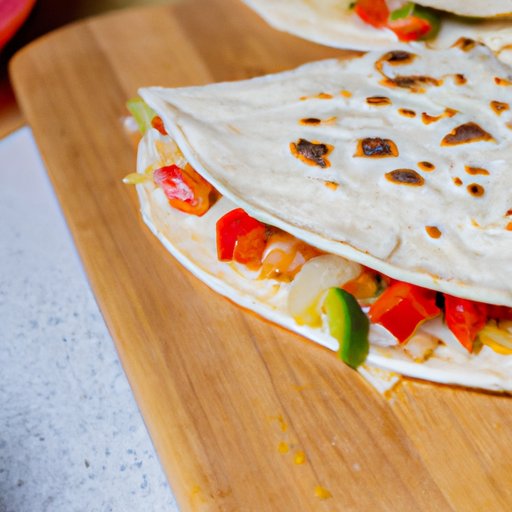Introduction
Quesadillas are a popular Mexican dish that is enjoyed all over the world. They are traditionally made by folding a flour tortilla around a filling of cheese, vegetables, and/or meats. Quesadillas have become increasingly popular in recent years, but are they actually healthy? In this article, we’ll explore the nutritional benefits of quesadillas, compare them to other Mexican dishes, and provide tips on how to make delicious quesadillas at home.
A Nutritional Breakdown of the Health Benefits of Quesadillas
The health benefits of quesadillas depend largely on what ingredients you put inside them. Generally speaking, quesadillas can be a good source of macronutrients, vitamins, and minerals. According to a study published in the Journal of Food Science and Technology, quesadillas made with whole-wheat tortillas contain significant amounts of carbohydrates, protein, and dietary fiber. They are also a good source of vitamins and minerals like calcium, iron, magnesium, and potassium.
In terms of calories and fat content, quesadillas can vary widely depending on the ingredients used. A traditional quesadilla made with cheese and a white flour tortilla will typically contain around 300-400 calories and 15-20 grams of fat. However, if you use low-fat or whole-grain ingredients, you can reduce the calorie and fat content significantly.

How to Make a Healthy Quesadilla at Home
Making a healthy quesadilla at home is easy. Start by choosing low-fat or whole-grain ingredients for the tortilla and fillings. For example, you could use a whole-wheat tortilla instead of a white flour tortilla, and choose low-fat cheese and lean meats. You can also add protein sources like beans, chicken, or fish for added nutrition.
Adding vegetables is another great way to boost the nutritional value of your quesadilla. You can use any type of vegetable, such as bell peppers, onions, spinach, mushrooms, or zucchini. Finally, here are some tips for making delicious quesadillas:
- Sprinkle cheese evenly over the entire tortilla.
- Add other ingredients directly on top of the cheese.
- Fold the tortilla in half before cooking.
- Cook on medium heat until the cheese is melted and the outside is golden brown.

Comparing the Nutrition of Quesadillas to Other Mexican Dishes
Quesadillas are often compared to other Mexican dishes, such as tacos, burritos, and enchiladas. While all four dishes are generally considered to be healthy, there are some differences in terms of nutrition. Tacos typically contain fewer calories than quesadillas, while burritos and enchiladas tend to be higher in calories due to their larger size and additional ingredients.
In terms of fat content, quesadillas typically contain more fat than tacos, but less fat than burritos and enchiladas. All four dishes are a good source of vitamins and minerals, but quesadillas tend to contain more fiber than the other three. Overall, all four dishes can be part of a healthy diet when eaten in moderation.

Examining the Pros and Cons of Eating Quesadillas Regularly
Eating quesadillas regularly can offer several health benefits, but there are also some potential drawbacks. The pros of eating quesadillas include:
- Quesadillas are a good source of complex carbohydrates, protein, and dietary fiber.
- They are a good source of vitamins and minerals.
- They can be a quick and easy meal option.
- They can easily be made vegetarian or vegan.
On the other hand, there are a few potential drawbacks to eating quesadillas regularly. These include:
- Quesadillas can be high in calories and fat if not made with low-fat ingredients.
- They are usually served with high-calorie sides like sour cream and guacamole.
- Some quesadilla fillings may contain high levels of sodium.
Exploring the Different Regional Variations of Quesadillas
Quesadillas are a popular dish all over the world, and each region has its own unique variation. In Mexico, quesadillas are typically made with corn tortillas and a variety of fillings, such as cheese, chorizo, and potatoes. In the southwestern United States, quesadillas are often made with flour tortillas and filled with cheese, chicken, and vegetables.
In Central America, quesadillas are usually made with a dough known as masa. The dough is filled with cheese, meat, and vegetables, then fried or grilled. This type of quesadilla is often served with salsa or sour cream.
Creating Delicious Vegetarian and Vegan Quesadillas
Vegetarian and vegan quesadillas can be just as delicious as their non-vegetarian counterparts. To make a vegetarian or vegan quesadilla, start by substituting the meat with a plant-based protein source, such as black beans, chickpeas, or tempeh. You can also use plant-based cheeses, such as vegan mozzarella or cheddar.
Don’t forget to add extra veggies to your quesadilla. Tomatoes, spinach, mushrooms, bell peppers, and onions all work well. Finally, you can top your quesadilla with salsa, guacamole, or vegan sour cream for a delicious and nutritious meal.
Conclusion
Quesadillas can be a healthy and delicious meal option when made with the right ingredients. They are a good source of macronutrients, vitamins, and minerals, and can easily be made vegetarian or vegan. When making quesadillas at home, it’s important to choose low-fat or whole-grain ingredients, and to add plenty of vegetables for added nutrition. With a few simple tweaks, you can enjoy a delicious and nutritious quesadilla any day of the week.
(Note: Is this article not meeting your expectations? Do you have knowledge or insights to share? Unlock new opportunities and expand your reach by joining our authors team. Click Registration to join us and share your expertise with our readers.)
